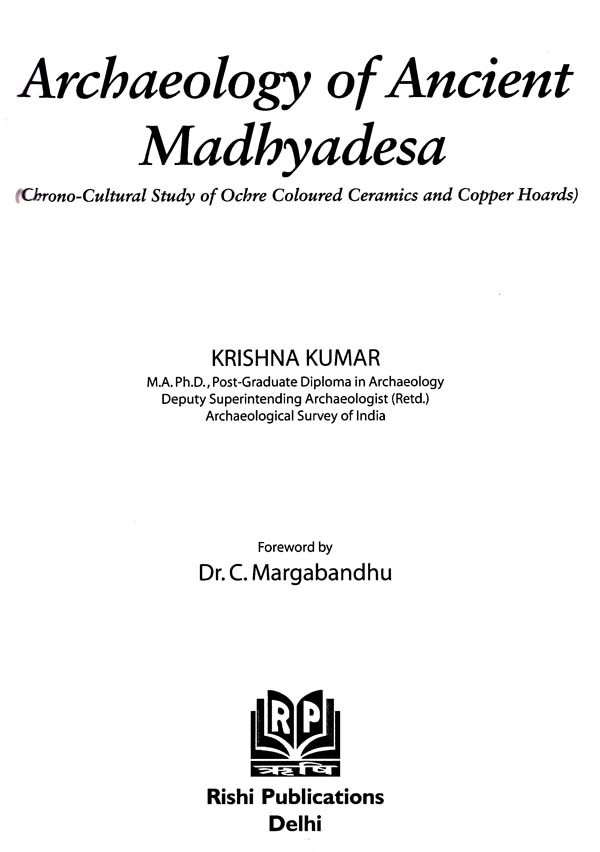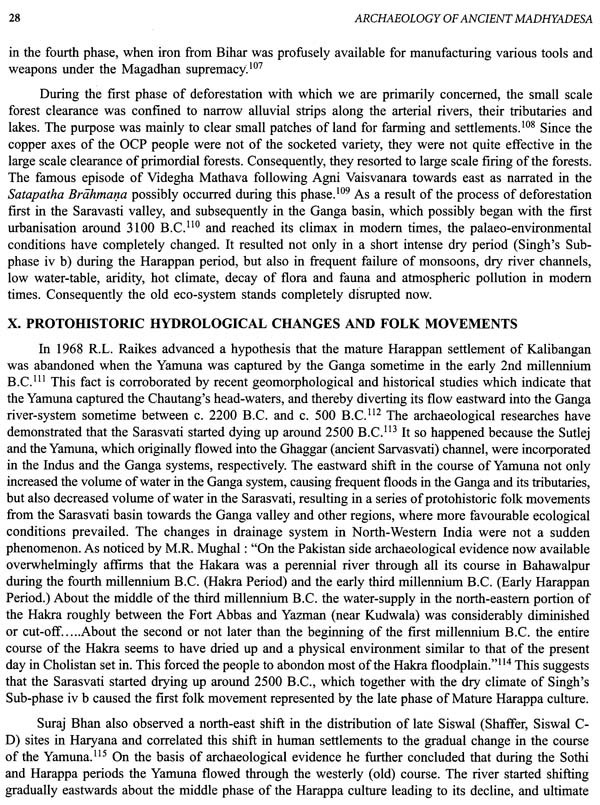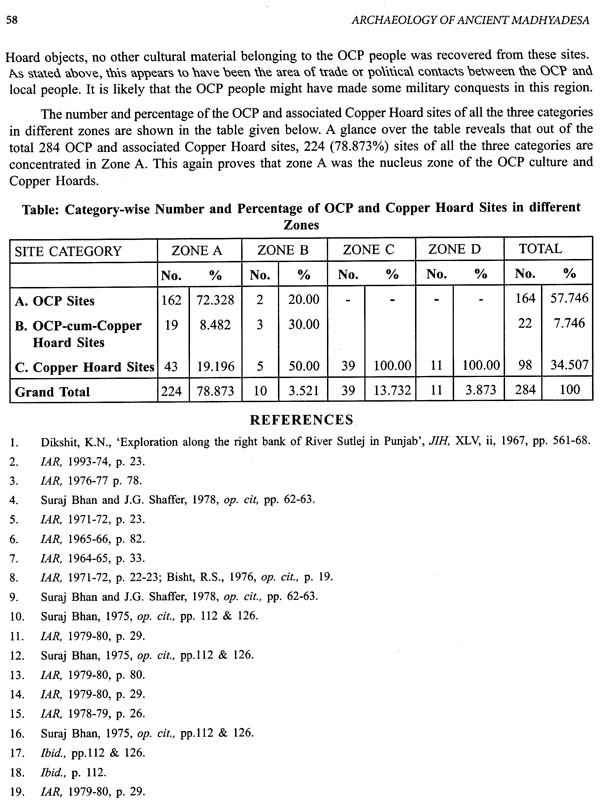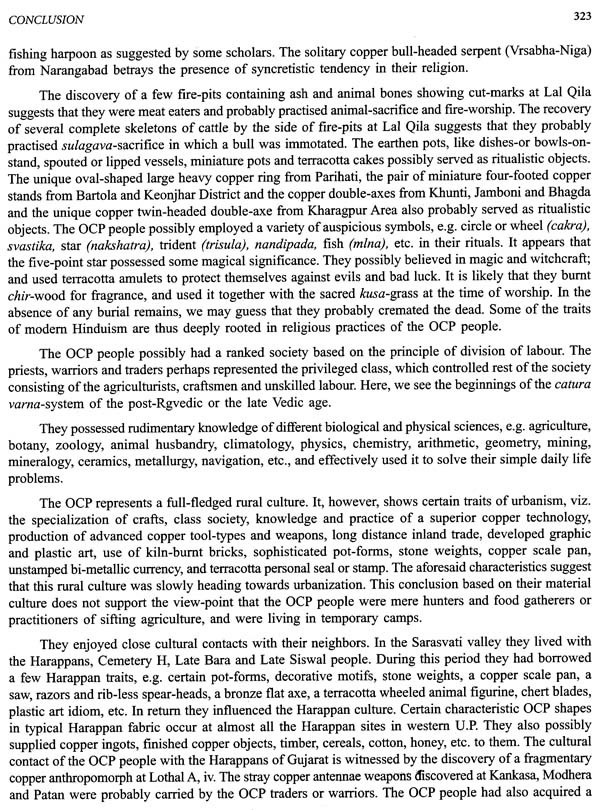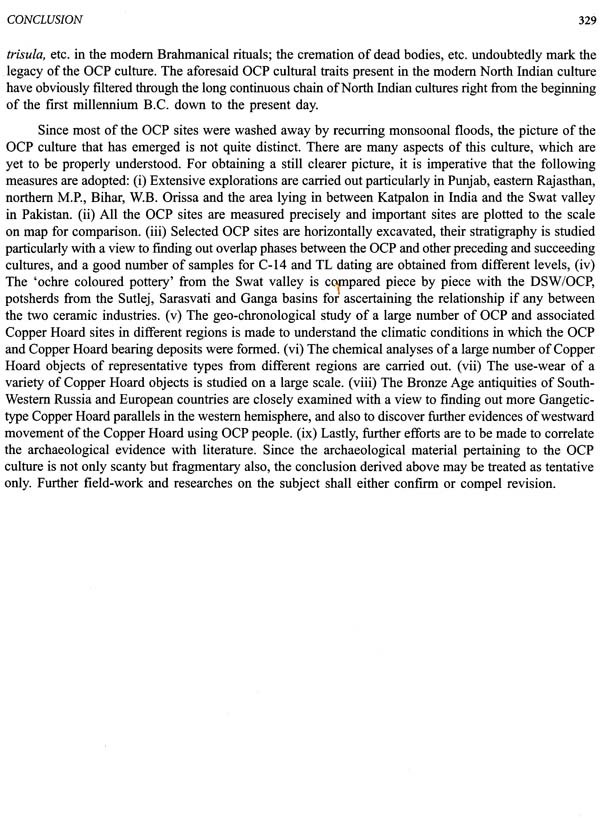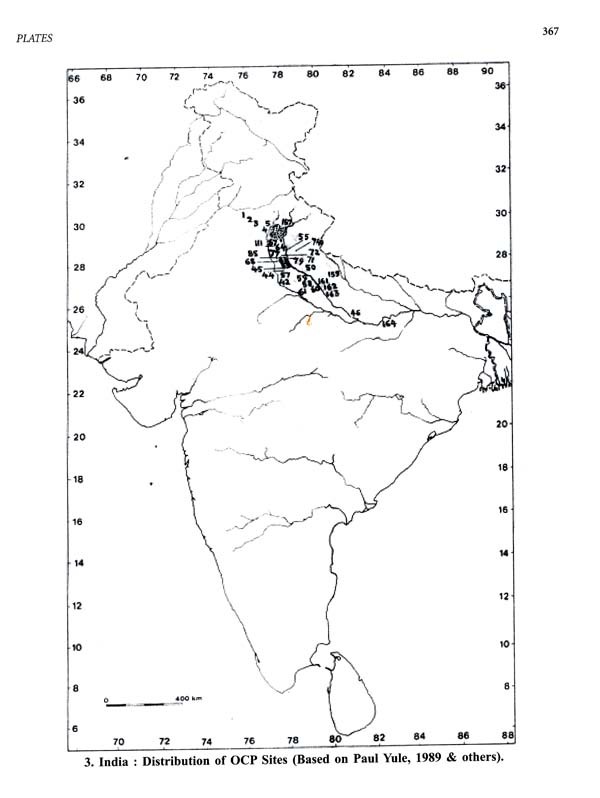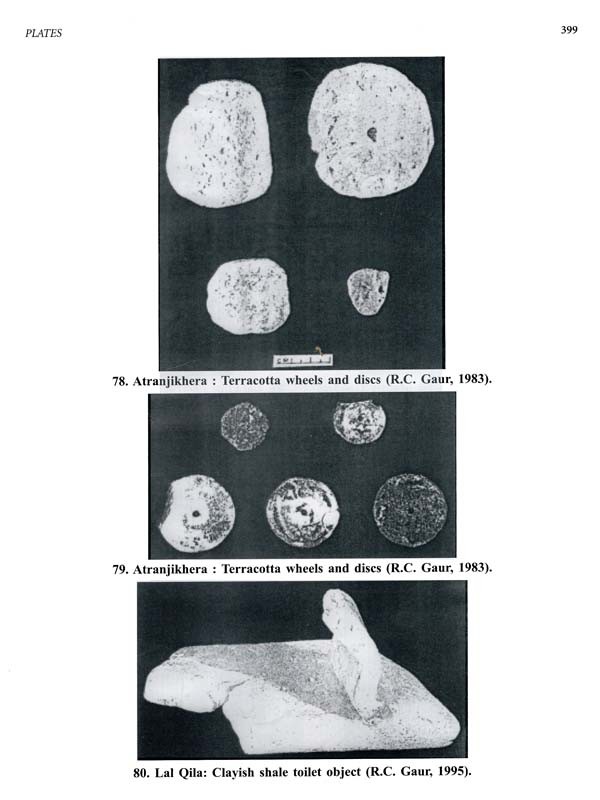
Archaeology of Ancient Madhyadesa: Chrono-Cultural Study of Ochre Coloured Ceramics and Copper Hoards
Book Specification
| Item Code: | UAT066 |
| Author: | Krishna Kumar |
| Publisher: | Rishi Publication, Delhi |
| Language: | English |
| Edition: | 2018 |
| ISBN: | 9788191024098 |
| Pages: | 428 (Throughout B/W Illustrations) |
| Cover: | HARDCOVER |
| Other Details | 11.50 X 9.00 inch |
| Weight | 1.36 kg |
Book Description
This is the first work of its kind on the archaeology of Ancient Madhyades referred to in the Manusmrti. It embodies a comprehensive study in the Ochine Coloured Pottery Culture including the OCP the associated Copper Hoards and miscellaneous finds It begins with a brief survey of the past discoveries researches and various problems and is followed by an account of the protohistoric deforestation hydrological changes, folk movements and also the present environment conditions prevailing in Northern India. The topography stratigraphy and assemblages of the OCP and the Copper Hoard sites are presented on the regional basis. The association of the DCP with the Copper Hoards has been demonstrated on the strength of the archaeological evidence. The typology, decorative motifs, graffiti-marks, technology and function of the OCP and the Copper Hoard objects are also discussed The source of metals in ancient India, the position of copper smiths and the purpose of the Copper Hoard deposits have also been explained.
It presents a vivid picture of the daily life of the people, viz. the settlement pattern, architecture, economic activities food-habits, hygeine, textile, ornaments, pastimes, religious practices, trade, currency, transportation, artistic and scientific achievements, walfare and funeral practices. Some fresh observations have also been made on their social, trade and political contacts with their neighbours within the subcontinent and their expansion in West Asia and Europe.
A region wise chronology and a tentative time-span for this culture have been suggested on the basis of available TL dates for different OCP sites. The current theories regarding the authorship and the eclipse of this culture have been closely examined and some fresh observations have been made on both the issues An attempt has also been made to understand, how through the long chain of the succeeding cultures it had contributed to the modem Indian culture. The areas of further research on the subject have also been indicated.
In the light of the Vedic literature, the enigmatic copper anthropomorphs have been identified as the earliest images of India, the most powerful deity of the Rgvedic Aryans, who were undoubtedly the indigenous people of South Asia. These figurines not only mark the beginnings of the Brahmanical iconography hi the Ganga Valley but towards the end of the second millennium BC, they also gave birth to the image of Nr. Varaha, the Boar incarnation of Vishnu. The silver plates, Le cow-heads and discs found in the Gungeria Copper Hoard have been considered as the Vedic currency, nisk and rukma respectively. The copper rings were employed both as bangles and ring money (mintra or khadi) by the people. The copper antennae weapons discovered in South India have been provisionally associated with Rama's journey from Ayodhya to Lanka.
Besides providing a post-script containing brief notes on the recent excavations at Dadupur. Madarpur and Sanauli, a select bibliography and an index, the text is also supported by several tables appendices, maps, line drawings, photographs and a chart showing the chronology of the OCP sites for the reader's convenience.
Dr Krishna Kumar, a resident of Fatehpur, was born on 3rd July 1936 in VILLAGE BHARSAWA, DISTRICT Kausambi (UP) He did his MA, and Ph.D. from the University of Allahabad; M.A. from the University of Kanpur, LT from the Government Central Pedagogical Institute, Allahabad and Post-Graduate Diploma in Archaeology from the School /Institute of Archaeololgy, New Delhi. He received Director General's Prize in the School of Archaeology, New Delhi. He took training in Field Archaeology at Kausambi and Kalibangan Excavations.
He joined the Archaeological Survey of India as Guide Lecturer in 1961, and worked at Agra, Khajuraho, Ellora, Ajanta and Sarnath; as Registering Officer, Antiquities and Art Treasures in Varanasi, Agra, Gorakhpur and Allahabad regions; as Asstt. Superintending Archaeologist in the Archaeological Museum, Chanderi and retired as Dy. Superintending Archaeologist in Lucknow Circle in 1994. He did the accessioning of antiquities in the Archaeological Museum, Sarnath and documentation of sculptures at Kalaniar Fort. He carried out explorations in Uttar Pradesh and Madhya Pradesh and discovered many archaeological sites and antiquities.
He has published more than seventy research articles on prehistory, protohistory, history, numismatics, epigraphy, art, architecture, iconography, religion and Ethno-Archaeology in reputed Indian and foreign journals. He has reviewed four books by Indian and foreign scholars, and has also edited two volumes on history, art and archaeology of Fatehpur district (U.P.)
He has attended many national and international seminars and presented research papers. He has participated in the Durzhba Dosti Exhibition organised under Indo-Soviet Colloboration at Tretyakov Art Gallery, Moscow (U.S.S.R.) in 1988. He is a life-member of several academic institutions and has been honoured by several government and private institutions.
It is a truism to characterize the Archaeological probings in the latter half of the last century dominated by interesting, yet eloquent discussion on the problem occurrence of the Ochre Coloured Ware and the accidental or chance discoveries of Copper Hoards at several sites and finding out their identity, connecting links and diffusion. With the christening of the Ochre Coloured Ware for the first time by Prof. B.B. Lal' in 1951, while excavating at Bisauli, a copper hoard site, subsequently the ware has been identified and the geographical spread at that time has been well summarized by Shri Krishna Deva", "it thus seems to extend from Bahadarabad to Noh near Bharatpur from north-to-south and from Katpalon near Jullundar to Ahichchhatra from west-to-east". On the basis of explorations "the focal point of OCP (short of Ochre Coloured Pottery) appears to be the upper Ganga-Yamuna Doab". In equal tone, Prof B.B. Lal' traces the antecedents of the Ochre Colour Ware and opines, "is it Late Harappan? Or is it an altogether different industry dominating the Ganga Valley, there being however interactions between this Ware and Harappan? There is another and dare say, a no less an important aspect of the problem of the Ochre Coloured Ware. At a number of places for example Bahadarabad, Nasirpur, Jhinjhana, Hastinapura, Noh, Ahichchhatra, Atranjikhera, etc, this ware has been noticed to occur sporadically in a matrix of otherwise clean earth which imperceptively merges into the natural soil". Again, though there is strong circumstantial evidence that this ware may have been associated with the Copper Hoards, "but unimpeachable evidence has yet to come". On similar lines, Shri M.N. Deshpande' analyses the problem and puts forth "ean we definitely establish the identity of this ware with the Copper Hoards.? We may have to consider the OCP and its relationship with Harappans also. Did it have an independent origin? Is it confined to the central Ganga Yamuna Doab? From where did it originate? Why in most OCP sites, clear stratification is absent? How does the character of the pottery differ in the upper central and lower Ganga-Yamuna Doab"? On the problem of the Copper Hoards and its finding which has so far "remained an unsolved mystery," Shri B.K. Thapar pointedly raised some questions, "Why were the copper hoards found localized at one place on a site? Is the disposition of the copper object in hoards, a normal feature in the life of the community. If so, does the find spot represent an armoury or the workshop of the guild of smiths? Another problem is the composition of the copper hoard and pottery bearing deposit. We may also consider "the functioning aspect of the objects and study their use marks if any. It has been pointed out elsewhere that this "tool kit has a pre-dominant hunting bias", but the evidence seems to be more indicative than conclusive. From the nature and contents of the various "Hoards", it is apparent "that they did not belong to an individual family but were intended to be used for a specific purpose by the community as a whole or atleast by a section of it". This would imply the organization of the society into "different sections, some practicing husbandry. The occurrence of stone pestles and mortars at Saipai, Lal- Qila and Ambkheri already suggests the use of cereals. In fact the economic base of Copper Hoard culture still remains to be properly investigated".
The pottery has rightly been called as the alphabet of archaeology. Its importance as an evidence in the reconstruction of past can never be over estimated. The post-Harappan archaeology of Northern India is largely characterized by a number of ceramic cultures that flourished during the second and the first millennium B.C. Of them, the Ochre Coloured Pottery, the Black-and-Red Ware, the Painted Grey Ware and the Northern Black Polished Ware are perhaps the most significant ones. Whereas several scholarly publications are available on the last three ceramic cultures, so far my knowledge goes no research dessertation or comprehensive work has yet been published exclusively on the OCP culture and associated Copper Hoards. The importance of this culture lies in the fact that it was a late contemporary of the Harappa culture in Punjab, Haryana and Uttar Pradesh. It also represents one of the earliest protohistoric cultures of ancient Madhyadesa. Hence, I took up this culture for an intensive study. The present work has grown out of my thesis approved for the D.Phil. degree of the University of Allahabad in year 2003.
The discovery of the Indus Valley culture in the early twenties proved to be a turning point in the history of Indian Archaeology. It had not only suddenly pushed back the antiquity of Indian civilization to the third millennium B.C., but also created a big chronological gap of about 1500 years in between the end of the Mature Harappa culture and the birth of the Buddha. Till recently, our knowledge of the 'Dark Age' particularly in the Ganga valley- the heart-land of Indian civilization-was confined to incidental discoveries of stray Copper Hoard objects in different parts of the subcontinent. The scholars had variously attributed their authorship either to the Indo-Aryan invaders advancing from the West' or to the Asuras coming from the East. Since no typical Copper Hoard object was ever found in a definite cultural context, the archaeologists knew practically nothing about their authors, excepting that they were expert copper smiths, who manufactured a variety of sophisticated copper objects. The Copper Hoards thus remained an enigma for the archaeologists.
**Contents and Sample Pages**
